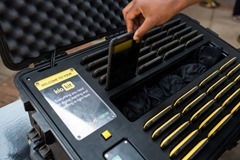 Frequent TeleRead commenter Michael W. Perry passed along this story about an interesting tablet kit for developing-world classrooms, made by a Kenyan company called BRCK. BRCK was founded in 2013 for the purpose of making a rugged hybrid WiFi/cellular router for places with poor communication infrastructure. However, in 2015 it launched the Kio Kit—effectively a digital classroom in a box that costs around US $5,000.
Frequent TeleRead commenter Michael W. Perry passed along this story about an interesting tablet kit for developing-world classrooms, made by a Kenyan company called BRCK. BRCK was founded in 2013 for the purpose of making a rugged hybrid WiFi/cellular router for places with poor communication infrastructure. However, in 2015 it launched the Kio Kit—effectively a digital classroom in a box that costs around US $5,000.
The Kio Kit is an almost literal turnkey connected classroom: A water-resistant trunk-sized travel case contains 40 Kio 7-inch tablets and a BRCK router. The travel case wirelessly each charges each tablet, and the whole unit can be charged from either a wall outlet, solar power, or even a car battery. The tablets come pre-loaded with educational software chosen by the purchaser, which can be a mix of free and paid material from providers such as the Kahn Academy or eKitabu, a Kenyan e-book company. Updates can provided through the cloud when connectivity is available.
The individual tablets are $99 each, which isn’t at all a bad price for a tablet of that size, which means the case, charging hardware, and router would come in at around $1,000.
The company has already sold these kits into schools in Kenya, Tanzania, the Solomon Islands, and has been getting inquiries from a number of countries including the US. The company is looking for additional investors, and its business manager says he would like to see Kio Kits become part of the emergency infrastructure used in refugee camps.
One problem the kits run into is that $5,000 is still a lot of money in the developing world. Even though they’ve gotten some help from banks with zero-interest loans and payment plans, that’s going to be a problem. However, BRCK hopes that parents, the community, and charitable donors can help to fill in the gaps.
It’s really intriguing to watch how the march of technology moves on toward providing better solutions to the issue of bringing education to the developing world. As tablets eclipse laptop use in the developed world, it stands to reason they would do so elsewhere, too. A $99 tablet is a lot more economical than a $400 OLPC laptop, and the rugged construction makes them great for use in the real world. Of course, the hardware is only half the equation—they need good software and media to go with them. But it sounds like they have some good content partners to handle that side of things.
It also sounds like it could be a good solution for US schools, especially ones in disadvantaged regions. Since the tablets don’t have individual chargers and only work when they’re connected to the BRCK router, there are no extra pieces to lose and the tablets are less likely to be stolen. It would be a lot cheaper than buying iPads, and potentially a lot more useful than buying Fires.
I will definitely be keeping an eye out for more news about the Kio Kit. It could very well have an important impact on education going forward.

































